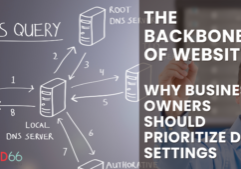The Digital Marketing Metrics That Actually Matter
When it comes to measuring digital marketing, it can be extremely easy to get distracted by all the different numbers you can pull. Add in that some agencies can pull numbers that seem incredible, yet they lack the explanation of what it means to your business.
If you often find yourself asking “What do they mean,” and “which ones actually matter,” here’s our breakdown of the top digital marketing metrics that you should be paying attention too.
Website Traffic is a Baseline Metric
For most of the digital marketing efforts that we do for our clients, whether it is social media, email campaigns, blogging, or digital advertising, our main goal is to try and drive people to a website to take action.
Your website is the online hub of your entire business. It’s where people go to learn more about you, connect, and engage.
Measuring website traffic, or the number of users visiting your website, is a baseline metric. We compare traffic month over month and year to date. These days, due to COVID, numbers are all over the place, so we dig a little deeper to see what is happening.
We can also tell you that anyone can get you traffic. So, looking at traffic counts only doesn’t tell you much. We’ve seen clients who have lower traffic this past month than they did last year, but their quality of leads and conversion rates are higher.
Website Traffic: Where Channels Visitors Come From Tells More
It’s always nice to see the amount of traffic coming to your website, but it’s important to see where they came from.
A marketing strategy only works if you know where your audience is, so understanding if they are coming to you from social media, a search engine, or advertisements can show how effective your marketing is.
Here are the main traffic sources to review:
- Organic Search: When a user finds your site organically through a search engine like Google, usually via non-branded terms.
- Direct: When a user visits your website by directly typing your URL into their browser, they already know who you are.
- Referral: When another user visits your website via an external link from another website. This is why we like to build relevant links from other websites to our client’s site.
- Social: When a user visits your website from a post or comment with your site’s URL on a social media platform such as Facebook, LinkedIn, Instagram, or Twitter.
- Paid Search: When a user clicks on a paid ad that brings them to your site. This can be broken down into Google text ads, display ads, and video ads.
- Google My Business: Those who find your local business listing and click through to the website.
We always break it down so you can see where people are coming from. And, we always filter out internal staff and IP addresses too.
Website Traffic: On-Site Metrics Matter, Too!
There are several stats to monitor including time on-site, bounce rate, and pages per visitor. Some can seem like vanity metrics, but together they tell a story.
Bounce rate is when someone hits your site and leaves right away. A high bounce rate can be a sign that your site load time is an issue, that it’s not what visitors expected, and more.
Time on-site is just that. How long people are on the website. Are they only spending a few seconds on the website? It could be due to the fact your call to action is to call you, or they’re looking for contact information.
If they’re spending a lot of time on the site and reviewing several pages, perhaps they’re learning more about you, or reading your helpful articles and getting the information they need at the time.
Conversion Rate: Taking Action on Your Website
While marketing efforts generally lead people to your website, the end goal is to get them to do something once they get there.
What exactly that Conversion Mechanism (action) is depends on the type of business. Conversions include making a purchase, reading your blog, submitting a lead form, downloading a catalog, or even signing up for a newsletter.
We look at conversion rates to measure the number of people that visited your site and took the action you wanted them to take.
Social Media Metrics (It's Not Just Fans or Followers)
We provide clients with social media dashboards to show their basic metrics with followers, engagement, and comments.
Again, these are standard metrics from anyone. Still, we dig into what these metrics mean based on the content audiences are engaging with.
Client Example
Recently, we had a client who had over 100 likes on one post, but hardly any clicks through to the website. It was a nice post celebrating anniversaries or key milestones for employees.
It’s a nice highlight and worth including because showing employees, anniversaries and what they like about a company also help with recruiting efforts.
More importantly, on that same report, we had a post that was about their products and processes. While this post did not have a lot of likes or comments, it had 50 clicks through to the article on the website.
These are both considered good metrics, but the one that is tied to helping them increase leads for their products or services is what we as their agency are focused on.
Then, we measure these funnels from what drives traffic to the site, what visitors do once they land there, and how we re-market to them via relevant display ads, email messages, or calls from the salespeople.
It's All About the Return on Investment or ROI
Ultimately, your digital marketing should bring a return on investment (ROI). Your ROI is how much money you spent on marketing versus how much money you earned as a result. This is an easy way to see if what you’re doing is worth it in the long run. ROI is easier to measure when it comes to things like paid ads.
Still, if you’re focused on lead generation you can create stats for your average customer value and your average close rate to give you an idea of what every lead is worth.
We work with many clients who are lead generation-focused. And, they may have a long sales cycle. It’s important to set some metrics to ensure that you as a client, and your agency, have some realistic measures for marketing purposes.
Here are few things to keep in mind:
- What is your average value of a customer?
- What digital marketing metrics should I track?
- Can you answer for every 10 good leads, how many do you close?
- How many new customers at that average value will deliver a positive ROI?
What Digital Marketing Metrics Should You Track?
These are just a few of the digital marketing metrics to track, that we feel are the most important when determining how effective online marketing is for our clients. However, these aren’t the only things we pay attention too and every business is a little different.
If you need help understanding what metrics you should be monitoring, or how to tell if what your current agency is sending you is relevant, send us a message!
We would love to chat about how to build you the best marketing strategy for your business.










